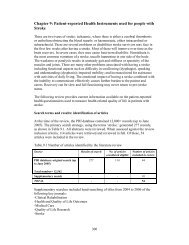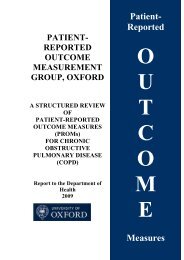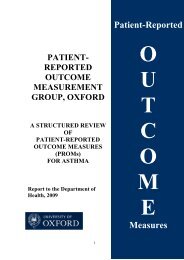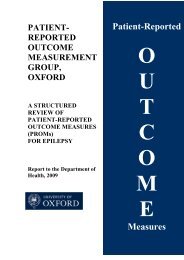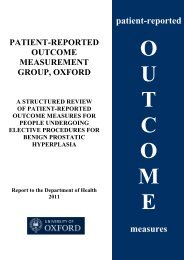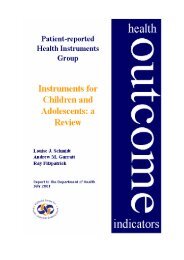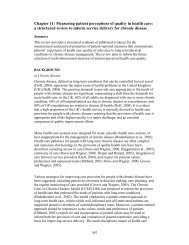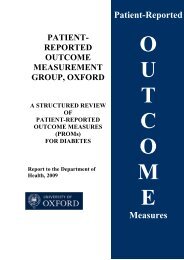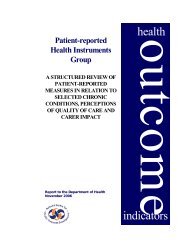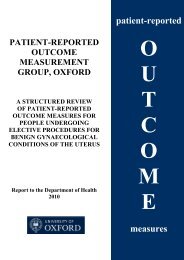2010 review - Patient-Reported Outcomes Measurement - University ...
2010 review - Patient-Reported Outcomes Measurement - University ...
2010 review - Patient-Reported Outcomes Measurement - University ...
Create successful ePaper yourself
Turn your PDF publications into a flip-book with our unique Google optimized e-Paper software.
Response rates of 93% and above were reported for in-hospital administration of a battery of<br />
instruments including the EQ-5D in the RITA-3 trial (Kim et al., 2005, UK), indicating good<br />
acceptability to patients. A return rate of 87% for postal administration of a battery of<br />
instruments including the EQ-5D was reported by the BHACAS trial comparing OPCAB and<br />
CABG-CPB (Ascione et al., 2004, UK). However, there were low rates of return for postal<br />
administration in three other studies – 64%, 52%, and 68%, respectively (Sollano et al., 1998;<br />
Denvir et al., 2006, UK; Dunning et al., 2008, UK).<br />
Interpretability of the EQ-VAS and EQ-5D global utility score was supported in the RITA-3<br />
trial (Kim et al., 2005, UK), with a 5-unit decline in VAS and a 0.068 decline in global utility<br />
score, respectively, corresponding to a 1-unit increase in angina grade, according to the CCS<br />
classification.<br />
c. Health Utilities Index (Feeny et al., 1995)<br />
The Health Utilities Index (HUI) was designed as a comprehensive framework for describing<br />
health status and health-related quality of life for use in clinical studies, population health<br />
surveys, and economic evaluations; the original HUI has been largely superseded by HUI2<br />
and HUI3 (Feeny et al., 1995). The Health Utilities Index Mark 3 (HUI3) consists of eight<br />
dimensions, rated by members of the general population as the most important attributes or<br />
dimensions of health status. For each attribute, there are five or six levels of functioning,<br />
ranging from highly impaired to normal, defined in terms of capacity rather than<br />
performance, to avoid confounding abilities with preferences. A combination of levels across<br />
the attributes constitutes a health state; utility scores, based on community preferences, can<br />
be obtained for each health state using an algorithm, with 0 representing death and 1 perfect<br />
health.<br />
Population norm data have been obtained from several large general population surveys.<br />
Over 15 different language versions of the HUI are available, and it has been used in more<br />
than 25 countries.<br />
Two studies were identified using HUI3 with patients undergoing elective coronary<br />
procedures, the most recent being from 2004; neither was conducted in the UK. One of the<br />
studies examined outcomes of PCI, the other feasibility of outcome measurement in CABG<br />
or PCI.<br />
In a head-to-head comparison between the HUI3 and the SF-6D with a sample of patients<br />
undergoing PCI (Hatoum et al., 2004; EXCITE study), both measures demonstrated<br />
discriminative validity, with significant differences in score distribution compared with the<br />
general population samples from whom preference weights were originally obtained, and<br />
significant between-group differences according to severity of angina (Hatoum et al., 2004).<br />
However, unlike the SF-6D, the HUI did not discriminate women and men, and patients<br />
requiring a longer stay in CCU (Hatoum et al., 2004).<br />
Concurrent validity was demonstrated by significant correlations between comparable<br />
domains of the HUI3 and SF-6D (Hatoum et al., 2004).<br />
Responsiveness of the HUI3 to change was also supported in the EXCITE study, with<br />
significant score changes between baseline (pre-discharge) and six months (Hatoum et al.,<br />
2004). However, HUI scores showed large ceiling effects, with 50% of the sample scoring at<br />
the top level in five of the eight dimensions, suggesting that the measure may lack precision,<br />
10



